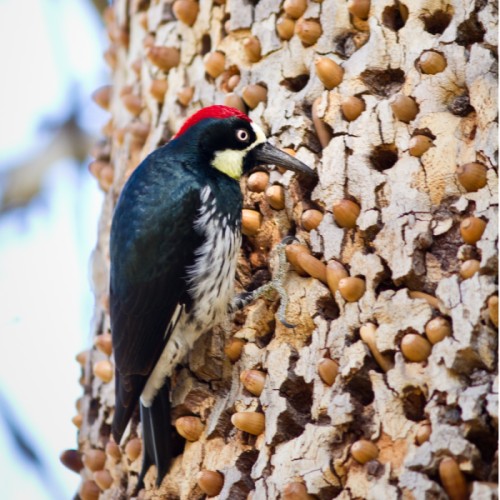Woodpeckers are a vast bird family, composed of approximately 217 species worldwide. They are found throughout the Americas, Eurasia
, and Africa, with the largest number of species occurring in the tropics of the New World. Here are a few woodpecker species you may encounter, along with some of the more unique members of the woodpecker family.
Red-headed woodpecker
The Red-headed Woodpecker is known for its fiery red-head and black and white body. It resides predominately in the Midwest and East Coast of America, occasionally drifting westward during the summer. It breeds in woodlands, orchards, parks, forest edges and swamps.

The red-headed woodpecker is one of the most aggressive members of the woodpecker family. Not only will it attack other woodpeckers who enter its territory, but it will also remove eggs from woodpecker nest boxes.
The red-headed woodpecker is the most omnivorous of all woodpeckers, feeding on seeds, nuts, berries, fruit, insects, bird eggs, nestlings and mice. It is one of only four woodpeckers who store food, hiding insects it has caught under bark or wood, including live grasshoppers, which it sticks into crevices so tight that they cannot escape.
White-headed Woodpecker
The White-headed woodpecker lives primarily in mixed coniferous forests in the western United States and British Columbia. Pine seeds are a staple of the white-headed woodpecker’s diet and in areas with many Ponderosa pines the species is most prevalent. The White-headed Woodpecker is generally sedentary, although it does move within mountain ranges.

The White-headed woodpecker plunges intact pine seed into a crevice in the bark of a tree, where it will punch away at it until it falls apart. It also feeds on a number of insects.
Both the male and female incubate the eggs. White-headed woodpeckers, which are monogamous, communicate frequently during the incubation period, often drumming softly from both inside and outside the nest cavity.
The Acorn Woodpecker
The acorn woodpecker, which lives in western forests down the coast of the United States and throughout Central America, devotes hours upon hours of its time to storing thousands of acorns in trees and telephone poles These acorns are usually placed in a single hole in a tree, called a granary hole, and can number up to 50,000.

The acorn woodpecker has a complex family structure, where several different individuals of one sex may breed within one family. Young woodpeckers remain with their families for many years and help their parents raise newborn woodpeckers.
The Acorn Woodpecker will sometimes use human-made structures to store acorns, drilling into fences, buildings and other structures.
Gila Woodpecker
This mid-size woodpecker primarily resides in the desert in the American Southwest and in Mexico. It has a brown face and neck with a black and white back.
The Gila woodpecker excavates a hole in a saguaro cactus to form a nest. After it pecks the hole, it will wait months for the pulp of the cactus to dry before occupying the cactus. The Gila woodpecker feeds off insects, fruit, seeds and the occasional lizard.
The Ivory-billed Woodpecker
Is the ivory-billed woodpecker extinct? That’s a question naturalists have been trying to answer for the last decade. This woodpecker, which is the third largest in the world, resided in the old-growth forests of the American Southeast and was decimated by forest cutting that occurred in 1800s.
It was though to be extinct by the middle of the twentieth century, but was allegedly discovered in 2005 in Arkansas. A number of recent expeditions in Arkansas and Louisiana in search of the Ivory-billed Woodpecker have come up empty. It is also possible that the species may exist in southeastern Cuba, where it was last sighted in 1986.
The Ivory-billed Woodpecker is present in a number of ancient native American archaeological sites, suggesting that it was used as ceremonial decor.
Browse our inventory of woodpecker houses here. Each woodpecker house we sell, like all of our products, is backed by a 30-day 100% money-back guarantee. Interested in learning more about woodpeckers? Then check out the articles below.
- Tips for Attracting Woodpeckers – Woodpeckers are a fabulous addition to any backyard or garden. If you’re thinking about adding a woodpecker box to your backyard, here are some tips on how to attract woodpeckers.
- Woodpecker Mating and Nesting Habits – The mating and nesting behavior of woodpeckers ranges from compassionate to violent. Learn more about woodpeckers’ nesting behavior.
- Physical Characteristics of Woodpeckers – The woodpecker is a marvel of evolution, having adapted itself to feeding habits that involve strenuous clinging, climbing and hammering. Learn more about the physical characteristics of woodpeckers.
- The Search for the Ivory-Billed Woodpecker – Few birds are as steeped in mysticism and controversy as the Ivory-billed Woodpecker. Ruled extinct in the 1940s, the existence of this woodpecker has been hotly debated as a number of sightings have recently surfaced.


